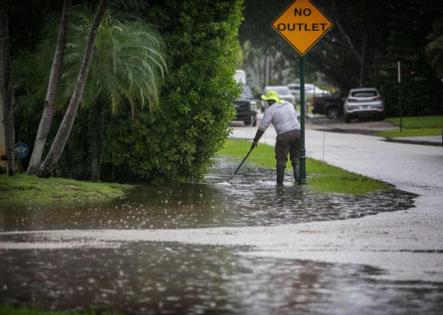King tides are coming, South Florida. They might bring record-breaking street flooding
Published in News & Features
MIAMI — South Florida streets could be underwater this week, without a tropical storm or hurricane in sight.
The next few days mark one of the highest tides of the year, known as a king tide. That tide could be strengthened by offshore winds blowing more water ashore, plus a drizzle of rain on already-soggy ground.
“Tide forecasts show that Miami could experience record-breaking high tides from the 16th-23rd, so be prepared for a week of tidal flooding around every high tide,” warned Brian McNoldy, a senior research associate at the University of Miami’s Rosenstiel School of Marine, Atmospheric and Earth Science, in a post on X.
The worst flooding is expected over the weekend, from Friday until Sunday, when water levels could be as much as 2 feet higher than normal. That’s enough to swamp streets, docks, yards — and even some very low-lying homes.
This year’s tides could be worsened by a bluster of wind from the east, Sammy Hadi, a meteorologist at the Miami office of the National Weather Service, noted in a post on X.
Some cities offer resources to help residents whose cars are at risk of flooding. Miami Beach, for instance, opens its parking garages for qualified residents. Miami has already started to place digital roadway signs to warn drivers about flooding roads. Both cities, as well as Miami-Dade County, also deploy temporary stormwater pumps in low-lying spots to help keep flooding at bay.
Climate amplified
King tides are a natural event. Tides are higher than usual during a full moon, which will occur over the weekend. But as humans keep burning fossil fuels, the atmosphere is warming and sea levels are rising. That pushes king tides even farther onshore, creeping into parks and roads that used to be dry all the time.
To combat that, South Florida cities and counties are spending hundreds of millions of dollars to elevate roads and install permanent stormwater pumps that force the water off the streets and back into canals and Biscayne Bay. They’re also installing devices that allow water to drain off streets but don’t allow it to surge back up through the drains.
It’s a slow and expensive process that hasn’t made it very far along the flood-prone coast. And the clock is ticking.
The high-tide floods now happen about three days a year, NOAA data shows. By 2050, they could occur 35 days a year.
©2024 Miami Herald. Visit at miamiherald.com. Distributed by Tribune Content Agency, LLC.







Comments